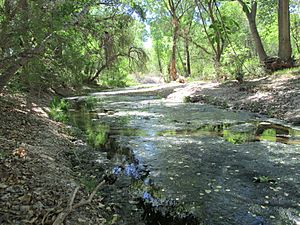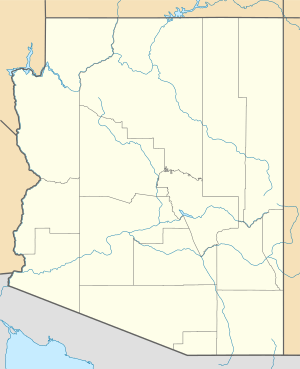Ciénega Creek facts for kids
Quick facts for kids Ciénega Creek |
|
|---|---|

A murky section of the creek
|
|
|
Location of the mouth of Ciénega Creek in Arizona
|
|
| Country | United States |
| Location | Arizona |
| Physical characteristics | |
| Main source | Canelo Hills |
| River mouth | Rillito River 3,212 ft (979 m) 32°02′03″N 110°40′32″W / 32.03417°N 110.67556°W |
Ciénega Creek is a special creek in southern Arizona. Its name means "Hundred Springs Creek" or "Marsh Creek" in English. It's unique because it's one of the best natural areas left along a river in the state. This creek sometimes dries up in parts, but other sections flow all year.
The creek starts in the Canelo Hills and flows about 50 miles (80 km) northwest. It goes to an area just outside Tucson. Here, it changes its name to Pantano Wash. Pantano Wash then flows through Tucson and eventually joins the Rillito River.
Contents
Where Does Ciénega Creek Flow?
Ciénega Creek begins in the Canelo Hills in Santa Cruz County. It flows northwest through a wide valley. This valley separates the Santa Rita Mountains and Empire Mountains to the west from the Whetstone Mountains to the east.
A rocky area called "the Narrows" acts like a natural dam. It divides the creek into upper and lower parts. At the Narrows, you can find many plants that grow near water, and the creek flows all the time.
The creek continues north through the lower valley. Then it turns west near Anderson and Wakefield Canyons. After crossing Interstate 10 near Vail, the creek crosses another rocky area. Here, water from underground comes up to the surface, making the creek flow all year again. Just north of Vail, Ciénega Creek becomes Pantano Wash. This wash continues through Tucson and connects with the Rillito River.
Animals and Plants of Ciénega Creek
Ciénega Creek is in a special spot between the Sonoran Desert and the Chihuahuan Desert. This means it has plants and animals from both desert types. The creek is home to amazing forests of cottonwood and willow trees. It also has thick mesquite woodlands.
These areas are very important for many bird species. Some birds, like the Southwestern willow flycatcher, Yellow-billed cuckoo, and Bell's vireo, are rare now because their natural homes have been lost.
Many amphibians and reptiles also live along the creek. These include different kinds of toads and snakes. You might see the checkered garter snake or the Madrean alligator lizard. The giant spotted whiptail lizard also lives here. The Mexican garter snake, which is rare in other parts of the United States, has a strong population in Ciénega Creek.
The endangered Chiricahua leopard frog lives only in the upper parts of the creek. The lowland leopard frog and the Sonoran mud turtle live throughout the stream. This shows that the creek is a healthy home for native water animals. Many types of snails and clams also live in the stream.
Ciénega Creek is one of the few streams in southern Arizona without non-native fish. The Las Cienegas National Conservation Area protects the largest natural group of the endangered Gila topminnow in the United States. It also has healthy numbers of the endangered Gila chub and the longfin dace.
Protecting Ciénega Creek
People are working hard to protect Ciénega Creek and its surroundings.
Las Cienegas National Conservation Area
The Las Cienegas National Conservation Area was created in 2000. Its goal is to protect the upper part of the Ciénega basin. The main office is at the historic Empire Ranch. This ranch is about 45 miles (72 km) southeast of Tucson, near Sonoita.
The conservation area covers 45,000 acres (18,000 ha). It includes large areas of grassland and woodland, along with Ciénega Creek itself. The Empire Ranch dates back to the 1870s and is open to visitors. It has been on the National Historic Register since 1976.
Ciénega Creek Natural Preserve
The Ciénega Creek Natural Preserve was started in 1986. It is about 20 miles (32 km) north of Empire Ranch. This preserve protects over 12 miles (19 km) of the creek. About half of this section has water flowing all year.
The preserve also has some historic places. These include the old town of Pantano and the Ciénega Bridge. This bridge was built between 1920 and 1921.
Pantano River Park
In Tucson, much of the Pantano Wash is now part of the Pantano River Park. This park has a paved path next to the wash. It also offers restrooms, water fountains, and picnic tables.
The Pantano River Park also has a Commemorative Tree Park. This project aims to plant many trees along the riverbank. These trees will help restore the area, control floods, and provide shade. Since 2012, over 100 special desert trees have been planted. Hundreds more will be added to reach a goal of 570 trees.
Gallery
-
Signs at the Ciénega Creek Natural Preserve, including a memorial for Jimmie Mercer, who was ambushed by a cattle rustler near Pantano in 1914
-
Hohokam bedrock mortar in Davidson Canyon, near its confluence with Ciénega Creek










